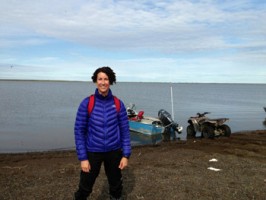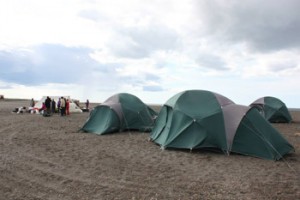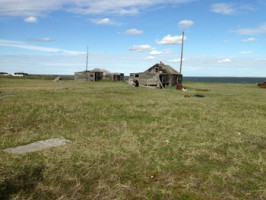Tales from Kali Camp, I of III
by Kathleen McCoy |
Courtesy of Jennifer Stone, Associate Professor of English
These stories describe my trip to Kali (aka Pt. Lay), AK in July, 2013 through the Educator Cross-Cultural Immersion program from the Alaska Humanities Forum. The camp I attended focused on Iñupiaq land use values and language. My participating partner was Barbara Petukh of the Mat-Su School District. All of our interactions included a mix of English, including local expressions, and Iñupiaq-these stories attempt to capture the mixing of languages that I experienced at camp (I'm still a beginner, so please excuse any errors I've made in my spelling or grammar). The stories also illustrate many of the Iñupiaq cultural values that I learned about and participated in at camp, including knowledge of language, sharing, cooperation, hard work and respect for nature. Quyanaqpak!
Arriving at Camp
As soon as we got off the plane in Kali, we were attacked by kiktubiaq-thousands of them swarmed us and tried to bite us. We immediately sprayed each other with bug dope. This made the kiktubiaq stop biting us, but they still flew around us and buzzed in our ears.
We were transported to the tasiq on a nunakuaġun, where all of the gear and people were loaded onto boats. They took us across the water to our camping spot, which was on a qikiqtaq near the old village site. The guides took us on a little loop in the tasiq so that we could see the remains of the recent sisoalik harvest. It was a good year-they harvested 26 sisoalik, which gave plenty of shares for the village to last through the winter.
At that point we were told to set up the tupiq, which would be our home for the next week. No one in the group had ever set up this kind of tupiq before, and some of the tupqutat and paugaq were missing or mixed up in the bags. It took us a while, but finally we were able to set up our camp and start to settle in.
Luckily, the uliqtuq started blowing so that the kiktubiaq stopped bothering us (thank goodness!). That evening we ate pankiqtaq and maktaak from the sisoalik. The pankiqtaq was tough and hard to chew-kind of like fishy beef jerky. The maktaak was like nothing I had ever tasted. It was chewy and very rich; I could see why people eat it to keep warm.
Terms Bug dope (insect repellant) Kiktubiaq (Mosquito) Maktaak (beluga blubber) Nunakuaġun (4-wheeler) Qikiqtaq (island) Pankiqtaq (dried meat) Sisoalik (beluga) Tasiq (lagoon) Tupiq (tent) Tupqutat and Paugaq (poles & stakes) Uliqtuq (Wind)
 "Tales from Kali Camp, I of III" is licensed under a Creative Commons Attribution-NonCommercial 4.0 International License.
"Tales from Kali Camp, I of III" is licensed under a Creative Commons Attribution-NonCommercial 4.0 International License.

















